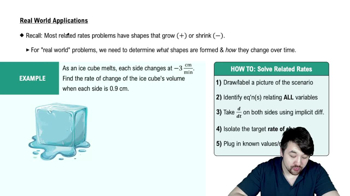Table of contents
- 0. Functions7h 52m
- Introduction to Functions16m
- Piecewise Functions10m
- Properties of Functions9m
- Common Functions1h 8m
- Transformations5m
- Combining Functions27m
- Exponent rules32m
- Exponential Functions28m
- Logarithmic Functions24m
- Properties of Logarithms34m
- Exponential & Logarithmic Equations35m
- Introduction to Trigonometric Functions38m
- Graphs of Trigonometric Functions44m
- Trigonometric Identities47m
- Inverse Trigonometric Functions48m
- 1. Limits and Continuity2h 2m
- 2. Intro to Derivatives1h 33m
- 3. Techniques of Differentiation3h 18m
- 4. Applications of Derivatives2h 38m
- 5. Graphical Applications of Derivatives6h 2m
- 6. Derivatives of Inverse, Exponential, & Logarithmic Functions2h 37m
- 7. Antiderivatives & Indefinite Integrals1h 26m
- 8. Definite Integrals4h 44m
- 9. Graphical Applications of Integrals2h 27m
- 10. Physics Applications of Integrals 2h 22m
4. Applications of Derivatives
Related Rates
Problem 3.11.14a
Textbook Question
Shrinking isosceles triangle The hypotenuse of an isosceles right triangle decreases in length at a rate of 4 m/s.
a. At what rate is the area of the triangle changing when the legs are 5 m long?
 Verified step by step guidance
Verified step by step guidance1
Identify the relationship between the hypotenuse and the legs of the isosceles right triangle. In an isosceles right triangle, the hypotenuse \( c \) is related to the legs \( a \) by the equation \( c = a\sqrt{2} \).
Differentiate the equation \( c = a\sqrt{2} \) with respect to time \( t \) to find the relationship between the rates of change of the hypotenuse and the legs. This gives \( \frac{dc}{dt} = \sqrt{2} \frac{da}{dt} \).
Substitute the given rate of change of the hypotenuse \( \frac{dc}{dt} = -4 \) m/s into the differentiated equation to solve for \( \frac{da}{dt} \), the rate of change of the legs.
Use the formula for the area \( A \) of an isosceles right triangle, \( A = \frac{1}{2}a^2 \), and differentiate it with respect to time \( t \) to find \( \frac{dA}{dt} \). This gives \( \frac{dA}{dt} = a \frac{da}{dt} \).
Substitute \( a = 5 \) m and the previously calculated \( \frac{da}{dt} \) into the differentiated area formula to find the rate at which the area is changing, \( \frac{dA}{dt} \).
 Verified video answer for a similar problem:
Verified video answer for a similar problem:This video solution was recommended by our tutors as helpful for the problem above
Video duration:
4mPlay a video:
Was this helpful?
Key Concepts
Here are the essential concepts you must grasp in order to answer the question correctly.
Related Rates
Related rates involve finding the rate at which one quantity changes in relation to another. In this problem, we need to relate the rate of change of the hypotenuse to the rate of change of the area of the triangle. This requires the use of derivatives to express how changes in one variable affect another over time.
Recommended video:

Intro To Related Rates
Area of a Triangle
The area of a triangle can be calculated using the formula A = (1/2) * base * height. For an isosceles right triangle, the legs are equal, and both serve as the base and height. Understanding how to express the area in terms of the leg length is crucial for determining how the area changes as the triangle shrinks.
Recommended video:

Estimating the Area Under a Curve Using Left Endpoints
Pythagorean Theorem
The Pythagorean theorem states that in a right triangle, the square of the hypotenuse is equal to the sum of the squares of the other two sides. This theorem is essential for relating the lengths of the legs of the triangle to the hypotenuse, allowing us to express the leg lengths in terms of the hypotenuse as it changes over time.
Recommended video:

Fundamental Theorem of Calculus Part 1
Related Videos
Related Practice





